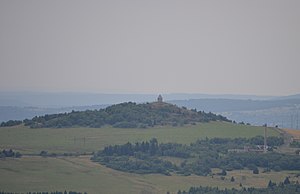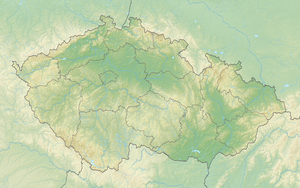Mědník
| Mědník | ||
|---|---|---|
|
The Mědník from Velký Špičák seen |
||
| height | 910 m nm | |
| location | Czech Republic | |
| Mountains | Ore Mountains | |
| Coordinates | 50 ° 25 '28 " N , 13 ° 6' 40" E | |
|
|
||
| rock | Skarn (calcium silicate) | |
| particularities | Summit chapel from 1674 | |
The Mědník (German Kupferhübel , also copper hill) is a 910 meter high mountain in the Ore Mountains in the Aussiger region on the territory of the Czech Republic . The German name was derived from the copper ore occurring here .
Location and surroundings
The Mědník is located in the upper Ore Mountains and forms an extremely striking elevation directly on the Ore Mountains ridge near Kadaň ( Kaaden ). The mountain town of Měděnec is located south directly at the foot of the mountain . The track of the Chomutov – Vejprty railway runs along the northern foot , and the striking winding towers of the disused Měděnec mine are located there. Large parts of the wider area are largely deserted. The vast expanse of water of the Preßnitz dam extends to the north .
history
Summit development and construction
Summit chapel
In 1674 Julius Franz von Sachsen-Lauenburg had the chapel for the “Immaculate Conception of the Virgin Mary” built on the summit, which still exists today. Above the door was the stone ducal Sachsen-Lauenburg coat of arms. In 1718, parts of the building were destroyed by lightning, but repaired soon afterwards. The natural scientist Franz Ignatz Cassian Hallaschka visited the summit in 1820 for geographic measurements . According to his descriptions, the chapel was in a desolate condition and in danger of collapsing, whereupon he gave the initiative to restore it. In the following year the building was repaired again. In 1921 the parish of Kupferberg had the chapel renovated.
Accommodation buildings
Below the summit, the first Swiss-style lodging house was built on a private initiative in 1873. This went to the Erzgebirgsvereine Kaaden , Klösterle , Komotau , Kupferberg, Preßnitz , Pürstein and Schmiedeberg with a purchase contract dated April 4, 1922 . Just two years later, on April 26, 1924, it fell victim to a fire. A new building was started in the same year and inaugurated on July 25, 1925. In the same year a road leading to the summit was completed.
This second lodging house burned down completely on March 11, 1935. Shortly afterwards, the committee of owners' associations decided again to build a new building, with the compensation received from the insurer covering a large part of the financing for the new building. The manufacturer Paul Elster from Schmiedeberg played an equally important part in the decision to build a new building. As a believer, he waived his claims when a new building was tackled. Appeals for donations were also launched. On May 25, 1936, construction work began on the third accommodation house and the topping-out ceremony was held on August 8 of that year. In addition to spacious guest, club and utility rooms, it also included two living rooms for the landlord on the ground floor. Seven guest rooms and two dormitories were available on the upper floor. All rooms were connected to a central heating system. The attic could be expanded for later extensions with guest rooms or dormitories. The grand opening of the house took place on November 14, 1936. In recognition of the support of the manufacturer Paul Elster, the building was named "Elster-Baude" by a resolution of the committee.
On August 5, 1939, the Elster-Baude was also partially destroyed by fire. The fire brigade managed to prevent the building from completely burning down and parts of the interior were also saved. The desire for a reconstruction probably had to be postponed due to the Second World War. After the end of the war - the Bohemian part of the Ore Mountains became part of Czechoslovakia again - the construction was canceled and the Mědník has since been without a mine.
Mining
The heaps and pings that cover the mountain on all sides bear witness to the earliest mining activities, when only shallow ore deposits were mined. Mining on and around the Mědník was probably started in the 15th century, and the participation of a Kaaden citizen with two " Kukus am Kupferberg" is mentioned for 1488 .
A mine was operated in the Kupferhübel from the early 16th century. According to a description by Franz Ambrosius Reuss , this consisted of the Mariahülfestollen , which was driven into the mountain in a northerly direction above the city. A shaft sunk directly from the summit was probably used for ventilation. There was also another shaft at the western foot of the mountain. Production continued until 1807, resumed briefly in 1843 and finally stopped entirely.
At the foot of the mountain is the entrance to the malachite caves of the Mariahilf tunnel, which opened on July 31, 1910. Currently (2018) there are two show mines (Mariahilfstolln and Gelobtes Land Stolln) which can be visited on request from the city or on special dates.
Mount Mednik (Kupferberg, Kupferhübel) is an important part of the historical mining heritage in the central Ore Mountains, which documents the mining of iron and copper ores from the hard Skarn rock over a period of almost six centuries. The morphologically striking hill is unique both in the Ore Mountains and in the European context due to the large number of historical mines. 70 tunnels and shafts were previously in operation on a small area, of which numerous broken mouth holes, funnel-shaped pings and waste rock heaps have been preserved. The most important area from a mining historical point of view is an approximately 100 m long strip of double shafts with shared spoil heaps on the northeast and eastern slope from the 15th / early 16th century.
view
In the north rises the Velký Špičák , further east of it lies the Preßnitz dam with the mountain Jelení hora ( Haßberg ). To the south-east, your gaze wanders over the vast North Bohemian Basin , which is characterized by lignite mining . B. Kadaň ( Kaaden ) with the Eger reservoir Nechranice can be seen.
In the south is only about 150 m south of Kupferberg ( Měděnec ) not far from the striking steep drop of the Ore Mountains down to the Egergraben , where z. B. Okounov recognizes. To the west you can see Horní Halže , Klínovec and Fichtelberg on the ridge path .
Paths to the summit
- The mountain is on the red marked ridge path ( European long-distance hiking trail E3 ), from Kupferberg an unmarked road leads to the summit.
- A blue- marked hiking trail leads from Perštejn (Pürstein) in the Egergraben to Měděnec (Kupferberg).
Attractions
- Mariahilfstolln show mine (Štola Marie Pomocná)
- Promised Land Stolln show mine (Štola země zaslíbená)
Reconstructed tunnel mouth hole of the Mariahilfstolln show mine
literature
- Kupferhübel booklet . In: Nordwestböhmischer Gebirgsvereins-Verband (Hrsg.): Erzgebirgs-Zeitung. Monthly for folklore and local history, hiking care and tourism . 12th issue of the 46th year. Teplitz-Schönau December 1925 ( znkr.cz ).
- Josef Brechensbauer : Kupferhübel or Kupferhügel? In: Gebirgsvereinsverband Sudetenland-West (Hrsg.): Erzgebirgs-Zeitung. Monthly for folklore and local history, hiking care and tourism . 1st and 2nd issue of the 63rd year, January-February. Teplitz-Schönau 1942, p. 2-3 ( znkr.cz ).
- Reinhart Heppner , Jörg Brückner , Helmut Schmidt: Saxon-Bohemian panoramic mountains of the western Ore Mountains in words and pictures with tourist information . Horb am Neckar, 2001, pp. 60-62
- Ulrich Möckel : Kupferberg and Kupferhübel. Historical pictures and texts from Kupferberg, from Kupferhübel and about the Erzgebirge poet and composer Reinhold Illing . Self-published, Schönheide 2009
- Franz Ambrosius Reuss : The gravel pit on the copper hill near Kupferberg . In: Mineralogical and mining remarks on Bohemia . Christian Friedrich Himburg, Berlin 1801 ( books.google.de ).
- Mining monuments in the mining region Erzgebirge / Krusnohory, German / Czech, Karlovarsky Kraj (Karlsbad region) 2014, nomination documentation for the project "Montane cultural landscape Erzgebirge-Krusnohory", Montanlandschaft Vrch Mednik (Kupferhübel) pp. 50–51.
Web links
Individual evidence
- ↑ a b c d Josef Hoßner: The Kupferhübel in history, legend and literature. In: Erzgebirgs-Zeitung , 12th issue of the 46th volume, 1925, p. 176. ( znkr.cz )
- ↑ Franz Ignatz Cassian Hallaschka : The princely mountain town of Kupferberg with the chapel on the Kupferhügel, in the Elbogner district . In: Heinrich Berghaus (Ed.): Annals of geography, ethnology and national studies . Fourth volume. Berlin 1831, p. 230 ( books.google.de ).
- ↑ Ernst Fischer: On the history of the reconstruction of the accommodation house on the copper hill. In: Erzgebirgs-Zeitung , 11th issue of the 57th volume, 1936, p. 133. ( znkr.cz )
- ↑ Ernst Fischer: On the history of the reconstruction of the accommodation house on the copper hill. ..., pp. 133-135.
- ^ Gustav Müller: The opening of the Elster-Baude. In: Erzgebirgs-Zeitung , 12th issue of the 57th year, 1936, pp. 161–163. ( znkr.cz )
- ↑ Reinhold Illing: On the fire of the Elsterbaude. In: Erzgebirgs-Zeitung , 5th and 6th issue of the 61st year, 1940, pp. 41–42. ( znkr.cz )
- ^ Franz Ambrosius Reuss : The gravel pit on the copper hill near Kupferberg. ..., p. 513.
- ↑ a b c Josef Hoßner: The Kupferhübel in history, legend and literature. ..., pp. 177-178.
- ^ Franz Ambrosius Reuss: The gravel pit on the copper hill near Kupferberg. ..., pp. 512-513.
- ↑ Mining monuments in the mining region Erzgebirge / Krusnohory, German / Czech, Karlovarský kraj (Karlsbad region) 2014, nomination documentation for the project "Montane Kulturlandschaft Erzgebirge-Krusnohory", Montanlandschaft Vrch Mednik (Kupferhübel) p. 51






